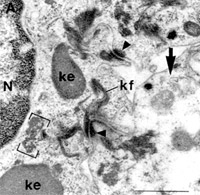"Reverse" Genetics Breaks the Code of Skin Diseases

Fuchs, Elaine
Human skin is remarkably resilient. Rub it, scratch it, or stretch it, and skin usually remains intact. One reason it's so tough is because proteins called keratins form a scaffold that maintains the mechanical strength of individual skin cells; other proteins help join the cells firmly one to another to form a tissue. Defective keratin underlies a disorder called epidermolysis bullosa simplex (EBS), in which the bumps and abrasions of everyday life result in severe skin blistering. Beginning in the 1990s, Elaine Fuchs discovered the genetic basis for EBS and more than a dozen other rare disorders in which keratins go awry in skin, muscle, and nerve cells. This research also provided clues to the way certain skin cancers and inflammatory skin disorders develop.

Skin sections from a patient with EBS. From Cell, 1991, 64: 365-380
For most of the 20th century, scientists searched for the genetic cause of a disease by finding families in which the disease is inherited, studying the DNA of affected individuals, homing in on the responsible gene, and then trying to understand how the defective protein caused the malfunction leading to the disease. Fuchs took the opposite approach, aptly called "reverse genetics": she started with the protein abnormality and then worked back to identify the human disease. A biochemist by training, Fuchs studied epidermal keratins to understand how they normally function. Then she and her colleagues identified key amino acid residues involved in their assembly into filaments and investigated the effects of genetically disrupting keratins in cultured skin cells. The next step was to see what skin abnormalities developed in mice whose epidermal keratin genes were manipulated. When the mice developed a disorder that looked similar to a human disease, Fuchs worked with a dermatologist to contact families with the disease and obtain a few skin biopsies from patients. By then her biochemical data had given her a good idea of which amino acids were most critical for keratins to function and where to look for genetic abnormalities. This revolutionary approach of using mouse genetics to understand human disease, now common practice, has guided researchers to the underlying basis of numerous human genetic disorders. It has been particularly effective in tracking down the genes for rare disorders, where it is difficult to recruit large numbers of patients to study by traditional methods.
In addition to the structural elements that make it tough, skin also can self-renew-it is a reservoir of stem cells-and Fuchs studies how these multipotent cells give rise to epidermal cells, hair follicles, and sebaceous glands. She and members of her lab have identified and characterized the embryonic and adult stem cells of the skin, an important step toward both understanding the normal process of tissue development and identifying what goes wrong in genetic skin diseases, including cancers. Fuchs also is investigating whether these cells can give rise to other cell types in the body for potential use in regenerative medicine.

President Barack Obama presents the National Medal of Science to Dr. Elaine Fuchs
Elaine Fuchs received the BS from the University of Illinois at Urbana-Champaign (1972) and the PhD from Princeton University (1977). She was a postdoc at the Massachusetts Institute of Technology from 1977 to 1980. That year Fuchs moved to the University of Chicago, where she advanced through the academic ranks, and in 1992 became the Amgen Professor of Basic Sciences. In 2002 Fuchs moved to The Rockefeller University, where she was named the Rebecca C. Lancefield Professor. She has been a Howard Hughes Medical Institute investigator since 1988. Among many honors and awards, Fuchs was named one of the Nation's Outstanding Scientists by the White House in 1985. She has been awarded the L'Oréal-UNESCO Award in the Life Sciences (2010) and the National Medal of Science (2008). She also has received the Bering Award and the Federation of American Societies for Experimental Biology Award for Scientific Excellence (2006), the Dickson Prize in Medicine (2004), the Novartis Drew Award in Biomedical Research (2003), the Cartwright Award from Columbia University (2002), and the Women in Cell Biology Senior Women's Career Achievement Award (1997). She is an elected member of the American Philosophical Society (2005), the American Academy of Arts and Sciences (1994), and the U.S. National Academy of Sciences (1995) and its Institute of Medicine (1994).
Selected Publications
Vassar R, Coulombe PA, Degenstein L, Albers K, and Fuch E. Mutant keratin expression in transgenic mice causes marked abnormalities resembling a human genetic skin disease. Cell, 1991, 64: 365-380
Coulombe PA, Hutton ME, Letai A, Hebert A, Paller AS, and Fuchs E. Point mutations in human keratin 14 genes of epidermolysis bullosa simplex patients: genetic and functional analyses. Cell, 1991, 66:1301-1311
Cheng J, Syder AJ, Yu Q-C, Letai A, Paller AS, and Fuchs E. The genetic basis of EH, a disorder of differentiation-specific epidermal keratin genes. Cell, 1992, 70: 811-819
Guo L, Degenstein L, Dowling J, Yu QC, Wollmann R, Perman B, and Fuchs E. Gene targeting of BPAG1: abnormalities in mechanical strength and cell migration in stratified epithelia and neurologic degeneration. Cell, 1995, 81: 233-243
Chan EF, Gat U, McNiff JM, and Fuchs, E. A common human skin tumour is caused by activating mutations in beta-catenin. Nat Genet, 1999, 21: 410-413
Tumbar T, Guasch G, Greco V, Blanpain C, Lowry WE, Rendl M, and Fuchs E. Defining the epithelial stem cell niche of the skin. Science, 2004, 303: 359-363
Lechler T and Fuchs E. Asymmetric cell divisions promote stratification and differentiation of mammalian skin. Nature, 2005, 437: 275-280
Li J, Greco V, Guasch G, Fuchs E, and Mombaerts P. Mice cloned from skin cells. Proc Natl Acad Sci USA, 2007, 104: 2738-2743
http://www.pnas.org/content/104/8/2738.full.pdf+html
Guasch G, Schober M, Pasolli HA, Conn EB, Polak L, and Fuchs E. Loss of TGFbeta signaling destabilizes homeostasis and promotes squamous cell carcinomas in stratified epithelia. Cancer Cell, 2007 Oct;12(4):293-5.
Yi R, Poy MN, Stoffel M, and Fuchs E. A skin microRNA promotes differentiation by repressing 'stemness'. Nature, 2008, 452(7184): 225-229
Further Reading
Fuchs E and Cleveland D. Structural scaffolding of IFs in health and disease. Science, 1998, 279: 514-519
Fuchs E. Scratching the surface of skin development. Nature, 2007, 445: 834-842
Fuchs E. Skin stem cells: rising to the surface. J Cell Biol, 2008, 180: 273-284
http://jcb.rupress.org/cgi/reprint/180/2/273
Blanpain C and Fuchs E. Epidermal homeostasis: a balancing act of stem cells in the skin. Nat Rev Mol Cell Biol, 2009, 10(3):207-217
Links
Elaine Fuchs, Laboratory of Mammalian Cell Biology and Development
http://www.rockefeller.edu/labheads/fuchs/intro.php
Elaine Fuchs, HHMI Investigator
http://www.hhmi.org/research/investigators/fuchs_bio.html
http://www.hhmi.org/research/investigators/fuchs.html
National Academy of Sciences InterView: Elaine Fuchs
http://www.nasonline.org/site/PageServer?pagename=INTERVIEWS_Elaine_Fuchs
The Making of Skin and Hair: A Geneticist's Perspective
http://www.rockefeller.edu/labheads/fuchs/mirsky.php
HHMI Bulletin May 2007: More Than Skin Deep
http://www.hhmi.org/bulletin/may2007/upfront/skin.html
